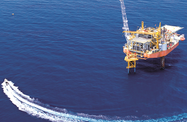Investors have put concerns about political uncertainty in Papua New Guinea (PNG) to one side, encouraged by the keen interest buyers are showing in the country’s natural gas blocks and major new finds.
PNG’s gas resources are earmarked to play a crucial part in its development, with reserves estimated at around 22.6trn cu feet (tcf), and much of the country has yet to be explored due to its challenging terrain.
In May 2012, the Australian company Oil Search confirmed that it had received offers from both new and existing players to participate in its exploration acreage in the Gulf of Papua. The news follows an announcement made some weeks earlier by Oil Search, together with its US-based partner ExxonMobil, that the gas zone at the P’nyang South-1 well has been found, through a “sidetrack well”, to run some 200 metres deeper than originally estimated.
The well forms part of an exploration campaign in the PNG highlands which supports the expansion of a $15.7bn PNG Liquefied Natural Gas (LNG) project, which is scheduled to come on-stream in 2014. The new find increases the total gas column to about 380 metres and doubles the field's estimated reserve to around 3 tcf.
Two LNG production units are currently under construction as part of the project. But the P'nyang find and the confidence it is generating have prompted speculation that a third LNG train, which would boost annual export capacity from 6.6m tonnes to around 10m tonnes, may well follow. “This outcome has virtually been assured with the better-than-anticipated result at the P’nyang South-1 and sidetrack that is presently being completed,” an industry source told The Australian.
Such confidence is likely to be generating much of the widespread interest in Oil Search’s untested Gulf of Papua assets. Chief executive Peter Botten told the media in May that drilling at its Trapia-1 mine would start in June, followed by work at the Hides prospect, which, with 3 tcf in proven reserves, is the mainstay of the LNG venture.
The new wave of investor interest follows a $280m deal struck in February by Japan’s Mitsubishi to buy stakes in several natural gas discoveries and prospects in the forelands area of western Papua New Guinea from Canada’s Talisman Energy. In a separate move, the Anglo-Dutch hydrocarbons giant Shell opened a representative office in the capital in the same month.
Gordon Ramsay, an analyst for UBS, told Radio New Zealand in February that PNG’s potential was generating widespread interest despite the challenges associated with its difficult terrain. “In the Southern Highlands region, the terrain has made it very difficult to explore in the area so there’s not a high level of maturity of exploration,” he said, “so there’s potential to find more gas.”
However, while interest in PNG’s gas resources is running high, concerns are also mounting that elections in late June could raise political tensions, sending ripple effects through the country’s energy projects.
PNG will be keen to avoid turbulence, with its plans to tap growing demand for LNG, especially in China, well under way. Forecasts from the International Energy Agency (IEA) in June show that LNG trade looks set to expand by 35% from 2015 onwards. China is expected to become PNG’s leading customer, with figures estimating that its consumption of LNG will double in the next five years.
In a bid to ensure it is in a strong position to meet the anticipated rise in demand, the government has moved to encourage larger energy companies to invest in PNG by setting a 180-day trigger date for terminating its 2009 project agreement with InterOil. It has also asked the Australia-based company to sell a minimum 50.5% stake in the Elk/Antelope reserves to a company experienced in operating a large-sized plant.
An affiliate of InterOil has described the government’s notice of intent as invalid. However, Port Morseby appears to be standing firm. “InterOil has for too long insisted on a development structure, which is designed to only meet its objectives of controlling the asset and the pace of developing it,” said the minister of petroleum and energy, William Duma. “This has led to a proposal calling for a piecemeal, incremental and fractured development implementation operated by InterOil and its affiliates, rather than by large-scale international operators with experience and capital.”
While the move is not without controversy, it is an indicator of the high confidence levels that PNG’s energy sector is generating, both within the country and internationally. Figures released by the International Monetary Fund (IMF) in June forecast that LNG production should boost real GDP by about 20% when it reaches full capacity in 2015.

